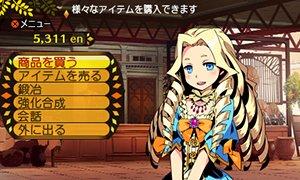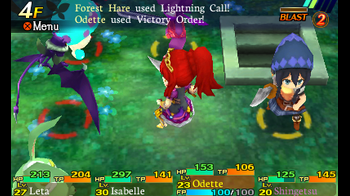
Etrian Mystery Dungeon Review
Delving into Etrian Mystery Dungeon was somewhat of an odd experience for me. What we have here is a title with gameplay structured in the Mystery Dungeon mold, but styled in the Etrian Odyssey aesthetic. While I had some second-hand familiarity with both of these franchises, I’ve never played either prior to booting up this crossover.
The premise to the game is quite straightforward. You arrive in the town of Aslarga, a hub for adventurers looking to find fame and fortune in the various Mystery Dungeons nearby. You meet a handful of townsfolk that provide various services, such as character recruitment and item storage. You form a guild, take on some quests, and then you are quickly sent off to see what waits in the mysterious labyrinths.
While there are some narrative elements sprinkled throughout, the storyline in the game is clearly not meant to be the focus here. There is enough to set up some context around the gameplay, but that's about it.
Etrian Mystery Dungeon is at heart, a party-based roguelike. This means that you’ll be finding yourself taking your team down through randomly generated dungeon floors, fighting enemy groups and trekking your way to the bottom.
If you fall in one of these dungeons, every item in your inventory will be lost as well as any money on hand. Some, but not all of your equipment will also be forfeit, making the penalty of defeat quite a significant one. And don’t think about hitting the reset button - that will result in the same penalty.
The game allows you some reprieve, though. You don’t lose levels you had prior to entering the dungeon, and you can also store money and equipment for safe keeping in the town’s inn. There are also various items you can buy that allow your party to escape dungeons safely when things become too dangerous to continue.
In fact, it’s not very hard to avoid a Game Over because the game always offers a way to sidestep them. At one point early on, my party was caught in an ambush and I had forgotten to put an escape item in my bag. That would end up being the only time I fell in a dungeon, and never managed that again for the rest of the game.
While I understand the desire to offer some conveniences to players, the game almost offers too many ways to make things easier.
There are ten total classes you can use in Etrian Mystery Dungeon, most of them found in various Etrian Odyssey games like the Gunner, Medic, Protector, etc., most of which have typical and self-explanatory job roles. The final class is the Wanderer, based off of Spike Chunsoft’s Shiren the Wanderer series, that boasts various traversal tools and abilities such as walking on water.
You can put any combination of four characters together as your dungeon-exploring party. You control one character and the other three follow along behind.
Each dungeon is set on a grid and every step taken counts as a single turn. When enemies are encountered, each participant waits for their turn in sequence, in that they can either use an ability or move once (including diagonally).
You only control the actions of your lead character and the others will work on their own in battle, including moving into position. Although, sometimes they will ask for player input when using certain skills. You can change the lead character at any time during your turn as well.
Although Etrian Mystery Dungeon is technically turn-based, most skills and abilities don’t take much time to use, and non-controlled participants act quickly, which keeps things flowing. Your AI party, for the most part, acts intelligently when it comes to their combat actions. The game offers some options in terms of formation in battle but I usually left them alone and they behaved without need for intervention.
The one exception to this is when your party is stuck in a hallway outside a room. In these situations, they will sit there motionless while the party leader engages any monsters. Here I would change the party lead to one of these stragglers to effectively push them out of the hallway to get them active. Besides this, party management is straightforward and accessible.
The long term goal of the game is to delve through several of these randomly-generated dungeons, gaining new equipment and abilities along the way so you can explore more difficult labyrinths. As the dungeons get longer, you’ll need to start constructing forts that act as waypoints for you to leave and enter from. What will cause the most headaches are the DOEs, large monsters previously seen in the Etrian Odyssey series that roam the halls, and destroy these important forts.
DOEs start at the bottom of dungeons and crawl their way up, trying to get to the town of Aslarga. Outside of reaching the dungeon bottom, your other task is to stop these DOEs from reaching the top. You could try to take them down outright, but they often prove too tough to take down with your 4 man squad (but not impossible).
When a DOE encounters a fort, they will destroy it and temporarily disappear from the dungeon, granting you some time to relax. If you want to, you can simply keep DOEs at bay by sacrificing forts in their path.
To get rid of them permanently, you can team up with a second 4 man squad stationed at the fort, taking an 8-on-1 approach to these nuisances. While this takes some effort to set up, it is easily the most effective way to to deal with these pseudo-bosses.
In this type of game, slow and steady wins the race. Taking time to gather crafting materials, killing enemies for EXP and loot will pay dividends in the long run. Gunning from staircase to staircase will not.
Most enemies are easily overcome by using basic strategies, whether it’s tanking or abusing their elemental weaknesses. I kept the same party configuration for the vast majority of the game, and it served me well up until late in the post-credits part of the game. I never experimented much with my party coordination because I never needed to. Even in the case where you might get overwhelmed by an ambush, all you have to do is use an escape item to avoid any penalty for dying.
In fact, I was very disappointed in how simple most bosses in the game ended up being. While they appear menacing, they always went down without any trouble at all. Even the final main game boss went down surprisingly quickly.
Due to the relative ease of difficulty of the game, going through room after room to find the stairs to the next floor ultimately became a bit of chore. Taking out enemies was never interesting because I never had to change things up in how I approached them. DOEs became the only legitimate source of trouble, but meeting them at a fort was a sure-fire way to vanquish them. Clearing them out of a dungeon took some time, but was never a challenge.
After the credits roll, several more dungeons open up, offering more enemies, more loot, and more bosses. Even in this post-credits portion of the game, I didn’t have to change up my party makeup or battle strategy until the very final boss. I was going through the motions and still finding success.
In terms of presentation, while the character models maintain a basic 'chibi' style, they do reflect equipment changes which is always fun to see. The game is quite colorful and the Etrian Odyssey-style artwork fits in well. I found myself a little disappointed in the musical offerings overall, although there are a few standout tracks.
In the end, Etrian Mystery Dungeon has all the right pieces to be a solid dungeon crawler: varied classes, deep dungeons, solid performance, and competent auxiliary systems. But it goes too far out of its way to lessen the burden on the player, which makes the act of playing the game much more mundane than it should be.


